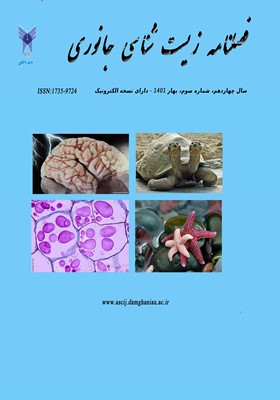بررسی اثر آلفاپینن بر میزان قند خون و فاکتورهای لیپیدی در موش صحرایی دیابتی
محورهای موضوعی : فصلنامه زیست شناسی جانوری
مریم رفیعی راد
1
![]() ,
عبدالحسن دولاح
2
,
سمیرا گودرزی
3
,
عبدالحسن دولاح
2
,
سمیرا گودرزی
3
1 - گروه زیستشناسی، واحد ایذه، دانشگاه آزاد اسلامی، ایذه، ایران.
2 - گروه زیست شناسی، واحد اهواز، دانشگاه آزاد اسلامی، اهواز، ایران
3 - گروه زیست شناسی، واحد ایذه، دانشگاه آزاد اسلامی، ایذه، ایران.
کلید واژه: گلوکز, موش صحرایی, پروفایل لیپیدی, دیابت, آلفاپینن,
چکیده مقاله :
بیماری دیابت اختلال در سوخت و ساز قندها، چربیها و پروتئینهای بدن میباشد که منجر به هیپرگلیسمی و هیپرلیپیدمی میشود. هدف از مطالعه حاضر بررسی اثر آلفاپینن بر میزان گلوکز و چربی خون در موشهای صحرایی دیابتی نر میباشد. 40 سر موش صحرایی نر نژاد ویستار به پنج گروه هشت تایی تقسیم شدند: گروه کنترل، گروه دیابتی، گروه دیابتی شاهد (دریافت کننده توئین (80 درصد حلال آلفاپینن) و گروههای تجربی که علاوه بر دیابتی شدن به ترتیب روزانه مقادیر100 و 200 میلیگرم بر کیلوگرم آلفاپینن را به صورت خوراکی و به مدت 14 روز دریافت کردند. در پایان، از همه گروهها نمونه خونی تهیه و میزان گلوکز و چربیهای خون آنها اندازهگیری شد. نتایج با استفاده از آزمون آنالیز واریانس و نرم افزار SPSS 21مورد تجزیه و تحلیل قرار گرفت. میزان گلوکز، تری گلیسرید (TG)و کلسترول تام و لیپوپروتئین با چگالی بسیارکم (VLDL) و لیپوپروتئین با چگالی کم (LDL) در گروههای دریافت کننده دوزهای 100 و 200 میلی گرم بر کیلوگرم آلفاپینن نسبت به گروه دیابتی کاهش معنیداری را نشان داد. لیپوپروتئین باچگالی بالا (HDL) در گروههای دریافت کننده دوزهای مختلف آلفاپینن نسبت به گروه دیابتی افزایش معنیداری را نشان داد. این نتایج نشان میدهند که آلفاپینن میتواند در درمان دیابت موثر باشد. تأثیر این ماده موثره احتمالاً به دلیل وجود خواص آنتی اکسیدانی آن است.
Diabetes mellitus refers to a disorder in the metabolism of sugars, fats, and proteins in the body, leading to hyperglycemia and hyperlipidemia. The present study was aimed at evaluating the effect of alpha-pinene on blood glucose and lipid levels in male diabetic rats. Forty male rats were divided into five groups of eight: control group, diabetic group, diabetic control group (receiving tween (80% alpha-solvent)) and experimental groups that in addition to becoming diabetic, the doses of 100 and 200 (mg/kg) of alpha-pinene were administered orally and daily for 14 days, respectively. Finally, blood samples were taken from all groups and their glucose and blood lipids were measured. The results were analyzed using analysis of variance (ANOVA) and SPSS21 software. The levels of glucose, triglyceride (TG) and total cholesterol and very low density lipoprotein (VLDL) and low density lipoprotein (LDL) in the groups receiving doses of 100 and 200 mg/kg of alpha-pinene showed a significant decrease compared to the diabetic group. High density lipoprotein (HDL) in the groups receiving different doses of alpha-pinene showed a significant increase compared to the diabetic group. These results indicate that alpha-pinene can be effective in the treatment of diabetes. The effect of this active ingredient is probably due to its antioxidant properties.
5. Goudarzi S., Rafieirad M. 2017. Evaluating the effect of α-pinene on motor activity, avoidance memory and lipid peroxidation in animal model of Parkinson disease in adult male rats. Research Journal of Pharmacognosy, 4(2): 53-63.
7. Hanefi O. 2017. Anti-inflammatory and Hypoglycemic Activities of Alpha-pinene. Acta Pharmaceutica Sinica B, 55(4): 7-14.
20. Rafieian-Kopaei M., Shahinfard N., Rouhi-Boroujeni H., Gharipour M., Darvishzadeh-Boroujeni P. 2014. Effects of Fe rulago angulata extract on serum lipids and lipid per oxidation. Evidence-Based Complementary and Alternative Medicine, 2014: 680856.
21. Rafieirad M., Eydipour Z., Alami Rostami S. 2018. Effects of antidepressants Hydro-alcoholic extract of Chevilan (Ferulago angulate) in model of ischemia/ hypoperfusion in adult male rats. Nova Biologica Reperta (NBR), 5(2): 137-143. [in Persian] link
28. Shi F., Zhao Y., Firempong C.K., Xu X. 2016. Preparation, characterization and pharmacokinetic studies of linalool-loaded nanostructured lipid carriers. Pharm. Biol, 54: 2320–2328.
37. Wang J., Hua W., Yue Y., Gao Z. 2010. MSU-S mesoporous materials: An efficient catalyst for isomerization of α-pinene. Bioresource. Technology, 101, :7224-7230.
38. Wang W., Li N., Luo M., Zu Y., Efferth, T.2012. Antibacterial activity and anticancer activity of Rosmarinus officinalis L. essential oil compared to that of its main components. Molecules, 17: 2704-2713.
_||_


